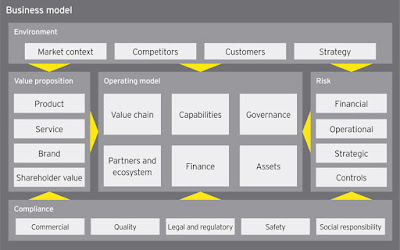IT & Enterprise Architecture Conference 2015 - Day 1
Today I attended the first day of the IT & Enterprise Architecture Conference 2015 at the Crowne Plaza in Auckland. This was my first time at the event and it was a good opportunity to network with the wider IT & Enterprise Architecture community. Below is a summary of my key notes.
Setting the scene: Enterprise Architecture 2015-2025
Craig Pitout, Senior Manager IT Advisory, EY (@CraigPitout)
- Cloud, Mobility, Big Data and Social Media are key forces of Digital Disruption
- Themes affecting enterprise agility
- Customer centric
- Product centric
- Internal efficiency
- Regulatory requirements
- Force for uniqueness vs Force for commonality
- Quantifying the impact
- Innovation impact vs Value potential
- Disruptive - disrupt the core
- Adjacent - change and expand
- Sustaining - incremental improvements
- Innovation impact vs Value potential
- EY Business Reference Model - Agile (http://www.ey.com/GL/en/Services/Advisory/EY-translate-strategy-into-execution)
- Agile behaviours
- Responsiveness to change
- Value-driven
- Practical experimentation
- Empowered, self-managing teams
- Customer communication and collaboration
- Continuous improvement
- Respect for people
- W123 - World-Class EA: The Agile Enterprise (http://www2.opengroup.org/ogsys/catalog/W123)
- The six qualities of business architecture
- Stakeholder experience
- Risk
- Alignment
- Efficiency
- Agility
- Business Achievability
- W146 - World-Class EA: Business Reference Model (http://www2.opengroup.org/ogsys/catalog/W146)
- Moving forward
- Become a digital practice
- Build a business architecture capability
- Establish agility goals
- In addition to To Do list build a To Don’t list
Facilitating system transformation across the Public Sector
Regine Deleu, All-of-Government Enterprise Architect, The Department of Internal Affairs (@rdeleu)
- Government Enterprise Architecture for New Zealand (GEA-NZ)
- applied at agency, sector and all-of-government level
- there is now v3.1, but worth checking out https://www.ict.govt.nz/assets/Guidance-and-Resources/Government-Enterprise-Architecture-for-New-Zealand-v3-0.pdf and http://www.slideshare.net/RegineDeleu/presentation-geanz-v30
- Five Business Areas
- New Zealand Society
- Individuals and Communities
- Businesses
- Civic Infrastrcture
- Government
- Data and Information
- Motivators
- Plans
- Controls
- Contracts
- Entities
- Parties
- Places
- Items
- Activities
- Cases
- Events
- Services
- Motivators
- Nine Application and ICT Services Domains
- Corporate Application
- Common Line of Business Applications
- Specialist Line of Business Applications
- End User Computing
- Identity and Access Management Services
- Security Services
- Data and Information Management Services
- ICT Components, Services and Tools
- Interfaces and Integration
- Four Infrastructure Domains
- Platform
- Network
- End User Equipment
- Facility
- Structure and Artefacts
- Accelerate Delivery Methodology (ADM)
CIO perspective: Leveraging the value of EA
Mike Clarke, CIO, SKYCITY Entertainment Group
- Proactively engage with business leaders on new ideas and enhancements
- Conversations distill into four pillars
- Digital Transformation
- Business Alignment & Direction
- IT Structure and Cost
- Security
- Business strategy has an IT delivery mechanism (c.f. IT strategy and delivery aligned to business strategy)
- "Cloud computing is not a technical construct, it is a commercial construct"
- Delivering value
- Are you part of the problem or part of the solution?
- Pragmatic
- Sufficient documentation, sufficient governance, sufficient testing
- Meets business need / solves the business problem
- Accelerates time to business value
- Makes the solution easier to support
- Makes the solution easier to expand
- Data is a key enabler to make decisions and drive change
- Attitude, Skill & Knowledge (ASK) is key
- Pragmatic approach
- Avoid an academic approach
- Purpose before action
- When / where required
- Focus on business value - investment needs to match the value
- Focus on improving IT delivery
- Right people in the right roles
- Debunking the SaaS myth - i.e. this is not an excuse for not having governance
- Relationships are key
- Be as transparent as possible
- Recruit IT people with a business focus
Value creation. Winning the challenge in small-medium organisations
Angus Wall, Enterprise Architect, Unison Networks
- Storytelling is super important
- Where do you invest money? EA is between strategy and system implementation
- Get involved in the business planning. Move away from strategy being done to us and being part of the process (partnership model).
- Business Disruption —> Target Business Outcome and Measure —> Architecture Strategy
- Align architecture strategy to business outcomes
- Assessing Business Impact
- Network & Operations
- Contracting
- Procurement & Logistics
- Commercial
- Finance
- HR
- Roadmap done for each domain, then aggregated
- Business Capability Model (kept at a high level)
- Manage Risk
- Sell Unison Products
- Operate Business
- Marketing & Communications
- Operate Network
- Procurement & Logistics
- Build & Maintain Network
- Make sure collateral is published and business focussed
Panel Discussion: EA for management utilisation. Are we on the same page?
Angus Wall, Enterprise Architect, Unison Networks
Michael Tapp, Principal Architect, Cyma (@MichaelTapp2)
Keith Delle Donne, Associate Director, PWC
Martyn Bowis, Enterprise Architect and TOGAF Trainer, Architecting the Enterprise
- Communication and Relationships is key, understand their motivations
- Get out of your business unit and engage wider across the organisation
- Work with the business to assist them with their strategy
- Be involved in the construction of the Business Plan
- Have a Business Capability Model and use this as a key discussion vehicle
- Super-impose a story over a picture the business is familiar with
- Minimum viable architecture
- You don’t want headless chicken agile, have guided agile
- Use industry models (helps with using the same language)
- You can teach skills, you can’t really teach attitude
- EA needs to cover with both strategic and tactical initiatives
- Principles guide decision making
- Share your vision
- Set expectations early on (particularly re bad news)
- Come with solutions, not problems
Masterclass: Bridging the communication gap
Rachael Cotton-Bronte, Director, FLINT-box (@Rachael_CBronte)
- Communication is the art of being understood
- "The problem with communication... is the illusion that it has been accomplished” George Bernhard Shaw
- We live in a time of unprecedented change
- Diversity is the norm
- Communication networks are increasingly complex
- From command & control to power & enablement
- Communication is essential to organisational success
- Communication is the key to building trust, promoting understanding, empowering and motivating others
- Words are like smashed eggs, once they go they go
- Plan your Message
- What are the key messages?
- Why is the message important?
- What are the possible objections?
- How will I address any objections?
- Avoid jargon
- Don’t make assumptions about levels of knowledge
- Communicate same message through multiple channels
- different people prefer to absorb information in different ways
- Paper, Audio, Video, Phone, Whiteboard
- Keep content below 111 words
- "Nothing I say this day is going to teach me anything. So if I’m going to learn I must do it by listening” Larry King
- Components of communication
- Physiology 55%
- Voice tones 38%
- Words 7%
- It’s what you don’t say that counts
- Listen actively
- Body Language
- Explore
- Question Open
- Reflection
- Clarify summarisation
- Understand your audience
- Think, See, Feel, Do
- Putting it together
- 1. Key message
- 2. Telling the story
- 3. Layering information
- 4. Test & Evaluate
- Talk about the elephants in the room (e.g. risks). Manage expectations.
- What do different people want?
- CIO
- Stability
- Cost of IT
- CMO
- Customer experience
- CEO
- ROI
- Stakeholder complexity
- CFO
- Where is most of the money going?
- Risk
- CIO
- How do you measure success? What are your business metrics?
- Project Managers at e-bay - 50% are INTJ
- People characteristics
- Conscientious
- Dominance
- Steady
- Influence
- 10:20:30 rule for pitching from Guy Kawasaki
- 10 Slides
- 20 minutes
- 30pt font is smallest that should be used
Would you hire yourself? The must-have skillset for proficient Architects
Paulo Rocha, Enterprise Architect, Watercare Services Limited
- EAs usually come from a variety of different paths; often from IT though and this impacts the perception of EA.
- Penn State University now has a degree for Enterprise Architecture (http://www.worldcampus.psu.edu/degrees-and-certificates/enterprise-architecture-masters/overview), nothing yet in NZ
- “World Class Enterprise Architecture” framework from the open group is about the “What” http://www.opengroup.org/india2011/presentations/Global%20Trends%20-%20Multinational%20Arch%20Deployments.pdf
- EA competency model has 7 core areas. Different roles (e.g. Designer vs Business Architect) require different aspects of this:
- Analytical Thinking
- Strategic Thinking
- Problem Solving
- Systems Thinking
- Creative Thinking
- Critical Thinking
- Architecture
- Design
- Information Analysis
- Modelling
- Process Improvement
- Roadmap Development
- Scenario Building
- Standards Development
- Systems Development
- System Integration
- Interpersonal skills
- Conflict Resolution
- Emotional Intelligence
- Influence
- Integrity
- Negotiation
- Political Savvy
- Relationship Bulding
- Communication
- Elicitation
- Facilitation
- Oral Presentations
- Written Communication
- Finance
- Cost Benefit Analysis
- Budgeting
- Management
- Asset Portfolio Management
- Coaching and Mentoring
- Decision Making
- Industry Regulation & Compliance
- Information Management
- Lifestyle Management
- Rick Management
- Project Management
- Performance Management
- Leadership
- Cyber & Information Security
- Emerging Technology Monitoring
- Enterprise Change Management
- Information Assurance
- Inspirational Direction
- Policy and Governance
- Project Portfolio Management
- Strategic Planning
- System Quality Assurance
- Technology Governance
- Analytical Thinking
- Need to also consider experience in addition to skills i.e. leverage lessons learnt through experience
Quick fire session: Where should an EA sit in the corporate organisation?
Paulo Rocha, Enterprise Architect, Watercare Services Limited
Michael Tapp, Principal Architect, Cyma (@MichaelTapp2)
Abhishek Anupuri, Senior Analyst, PWC
Martyn Bowis, Enterprise Architect and TOGAF Trainer, Architecting the Enterprise
- It is more important about where you can impact change as opposed to where you are in an organisational hierarchy
- Leadership is about influence rather than a particular title
- Outcome is more important than output and process
- With too much process you kill the art
Summary of my key takeaways
- Continue to embrace agile behaviours (Responsiveness to change; Value-driven; Practical experimentation; Empowered, self-managing teams; Customer communication and collaboration; Continuous improvement; Respect for people)
- The six qualities of business architecture would be useful for rapidly assessing the impact of an initiative (Stakeholder experience; Risk; Alignment; Efficiency; Agility; Business Achievability)
- GEA-NZ has some good information publicly available that is worth checking out for evolving an EA
- Sufficient documentation, sufficient governance, sufficient testing
- When recruiting in IT, recruit people with a business focus
- Get involved in the business planning. Move away from strategy being done to you and be part of the process (partnership model).
- Align architecture strategy to business outcomes
- Use Business Capability Model to show at a high level where work is occurring
- Make sure collateral is published and business focussed
- Communicate same message through multiple channels
- Physiology is 55% of communication, voice tones 38%, words 7%
- The EA competency model could be useful for recruitment and working out areas to grow in






Comments
Post a Comment